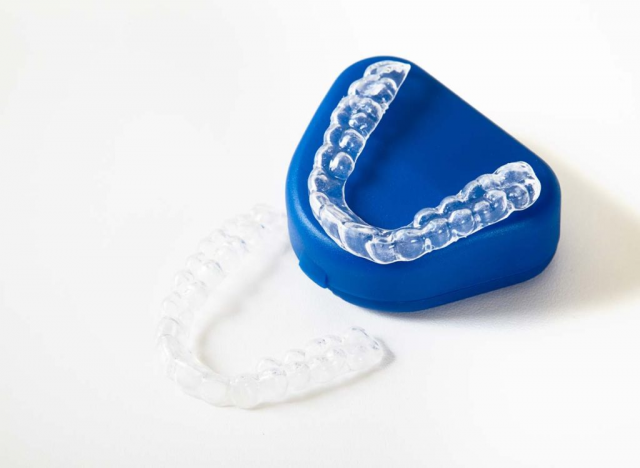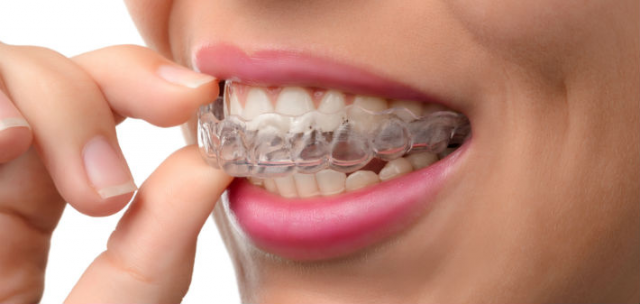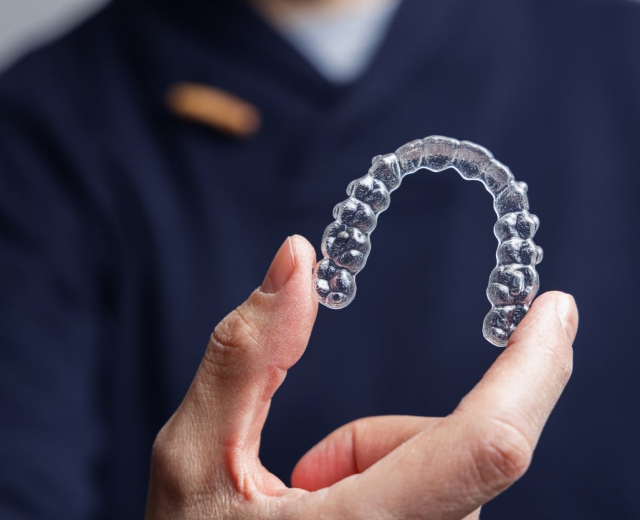What’s the Price of Invisalign?
In Singapore, Invisalign treatment costs can vary depending on whether it’s administered by a general dentist or an orthodontist. Typically, the range is between S$4,500 and S$8,000+ for general dentists and between S$7,000 and S$9,500+ for orthodontists.
It’s essential to clarify with your dentist whether the quoted price includes refinement aligners for achieving optimal results. Ultimately, the total cost of Invisalign treatment is determined by individual needs, requirements, and the complexity of the case.
Ready for a Confident Smile?
Get Your Invisalign Pricing Estimate Now!
Discover the benefits of Invisalign and get your personalized pricing estimate today for a straighter, more beautiful smile!
Cost of Invisalign at Braces Practice
For The Braces Practice, our price of Invisalign is S$6,650 (Student price before GST) and S$7,050 (Adult price before GST). These figures exclude expenses such as pre-treatment assessments, mid-treatment procedures up to 2 refinement aligners, and post-treatment costs like dental x-rays, treatment planning, and retainers.
What Contributes to the Cost of Invisalign?
The cost of Invisalign treatment in Singapore is influenced by various factors including the type of aligners required, treatment duration, refinements, maintenance, and the experience level of your chosen dentist. Due to the uniqueness of each smile, there isn’t a standard quote applicable to all dental conditions and jaw alignments.
The primary factor determining the cost of Invisalign is the condition of your teeth. More complex misalignments and bite issues typically necessitate a greater number of aligners and refinements, leading to higher expenses.
To gauge potential costs, it is advisable to consult multiple clinics regarding their Invisalign packages. This approach can provide insight into the minimum expenditure required to initiate treatment based on your specific dental condition.
Types of Invisalign Treatment Plans
| Express | Lite | Moderate | Comprehensive | |
| Number of aligners (Per Arch) | Up to 7 Invisalign clear aligners | Up to 14 Invisalign clear aligners | Up to 26 Invisalign clear aligners | Unlimited Invisalign clear aligners |
| Ideal cases for treatment | Minor shifts in tooth position and relapse. | Minor teeth spacing and crowding concerns. | Mild instances of overcrowding and spacing problems. | Severe dental problems, including crowding of the teeth. |
The Type of Invisalign Aligner Needed
In Singapore, the cost of Invisalign treatment is influenced by the specific type of aligner needed for your condition. Different aligner types cater to various degrees of alignment issues, ranging from mild to severe.
Moreover, the number of aligner trays required also impacts the overall expense. A greater number of sets needed to address your dental concerns will result in a higher treatment cost.
Invisalign Express
Invisalign Express is ideal for addressing minor dental concerns. These aligners are well-suited for patients requiring minor adjustments, typically resolving issues such as slight misalignment or minimal crowding within a six-month treatment period, consisting of around six to seven aligners. Additionally, Invisalign Express is beneficial for individuals who have previously undergone orthodontic treatment with braces but are experiencing a recurrence of misalignment.
Invisalign Lite
Invisalign Lite is tailored for individuals with mild crowding or spacing issues. Similar to Invisalign Express, this option offers noticeable improvements over a comparable timeframe, albeit at a slightly slower pace. Typically, patients undergoing Invisalign Lite treatment receive approximately 14 sets of aligners, with the process lasting a minimum of 8 to 10 months.
Invisalign Moderate
Invisalign Moderate is recommended for moderate to mildly complex crowding. This option involves a minimum of 26 aligners and requires treatment for at least a year to achieve desired results.
Invisalign Comprehensive
Invisalign Comprehensive is reserved for addressing severe crowding concerns. This option involves a longer treatment duration and is specifically designed to tackle severely crowded teeth. Our orthodontist will evaluate your condition and prescribe the necessary number of aligners to achieve the desired correction, with treatment continuing until optimal results are attained.
Are There Subsidies for Invisalign?
Our doctors and staff frequently encounter this question. Regrettably, there are no government/MOH subsidies available for orthodontic procedures like Invisalign, whether at government hospitals, public clinics, or private clinics in Singapore.
Is the CHAS Card applicable for Invisalign?
No, as mentioned earlier, there are no government subsidies available for Invisalign treatment. This is primarily because Invisalign treatment is considered elective, meaning it is not deemed necessary for basic functioning. Therefore, if you opt for Invisalign for aesthetic reasons, you are responsible for covering the treatment costs yourself.
As a result, it is difficult to justify the use of taxpayers’ money for a procedure that is not deemed essential, unlike surgical procedures such as wisdom teeth extraction or dental implant placements.
Can Medisave be used for Invisalign or braces?
Unfortunately, Invisalign or other orthodontic procedures are not eligible for Medisave claims.
As a general guideline, Medisave can only be used for procedures that require dental or oral surgery, such as dental implants, surgical wisdom tooth extractions, and gum surgery.
If you are interested in learning more about procedures eligible for Medisave claims, you can refer to this article that discusses the different types of Medisave claims available for dentistry in Singapore.
Does dental insurance cover Invisalign?
Orthodontic treatments like Invisalign are typically not covered under standard dental insurance plans.
Usually, dental insurance coverage for orthodontic treatments, including Invisalign, is an additional benefit and not a standard feature of most dental insurance plans.
Furthermore, Invisalign treatment is often considered a non-essential aesthetic treatment and is generally not covered even with dental insurance.
Frequently Asked Questions (FAQS) about Invisalign Price in Singapore
Why is Invisalign so expensive?
Invisalign treatment tends to be expensive for a few reasons.
Firstly, the materials used in Invisalign aligners are specialized and high-quality, which contributes to the overall cost.
Secondly, each set of aligners is custom-made for the individual, requiring precise 3D imaging, computer modeling, and manufacturing processes. Additionally, the cost of your treatment includes regular check-ups and adjustments with your orthodontist.
Lastly, the expertise of the orthodontist and the brand name also play a role in the overall cost. While the price may seem high, many people find that the benefits of Invisalign, including its comfort and discreet appearance, make it a worthwhile investment in their smile and overall confidence.
Can I use Medisave for Invisalign?
Invisalign treatment is not subsidized because it is categorized as a cosmetic procedure.
What is the cheapest Invisalign price?
For simpler cases that require fewer aligners or a shorter treatment duration, like Invisalign Express, the cost typically ranges from $4,500 to $5,500. However, your individual case and your orthodontist’s expertise can affect the final cost. To get an accurate quote, consult with our orthodontist.
Is Invisalign more expensive than braces?
In many instances, Invisalign tends to be pricier compared to traditional braces.
However, the precise cost of either treatment can only be determined through a comprehensive examination and consultation with your dentist.
What is the difference between Invisalign and braces?
Invisalign, a type of orthodontic treatment, differs from traditional braces in several ways:
Appearance: Invisalign aligners are clear and removable, while braces are fixed and easily visible on the teeth.
Comfort: Invisalign treatment offers a more comfortable experience, providing gradual and gentle tooth movement.
Oral hygiene: Invisalign allows for better oral hygiene compared to braces, as the aligners can be removed for brushing and flossing.
Dietary restrictions: With Invisalign, there are minimal dietary restrictions, whereas braces may require avoiding certain foods.
Follow-up visits: Invisalign treatment typically requires fewer and shorter visits to the dentist compared to traditional braces.
Treatment for complex conditions: While braces can effectively treat more complex orthodontic conditions, Invisalign has limitations in treating certain cases.
Compliance with treatment: Ensuring patient compliance with Invisalign treatment can be more challenging compared to traditional braces.
Cost of treatment: In general, Invisalign treatment tends to be more costly than traditional braces.
Learn more about Invisalign vs Braces
How long does it take to straighten my teeth with Invisalign?
The duration of treatment can vary considerably depending on your specific orthodontic needs and the desired outcome.
While a typical treatment with traditional braces may take about 1.5 to 2 years, our clinic offers orthodontic devices that can expedite the treatment process.
How many hours should I wear my aligners each day?
It is recommended to wear the aligners for a minimum of 21-22 hours per day.
How does Invisalign straighten my teeth?
Invisalign works by using a series of custom-made, clear plastic aligners to gradually shift your teeth into the desired position. These aligners are designed based on a 3D model of your teeth, created using digital scans. Throughout your treatment, you will wear a series of aligners, each slightly different from the last, to gently and gradually move your teeth into the desired alignment. The aligners apply controlled force to specific teeth at predetermined times, effectively straightening them over time. Regular check-ups with your orthodontist will ensure that your treatment progresses as planned.
How often do I need to change my aligners?
The frequency of changing your aligners typically varies according to your dentist’s instructions. Typically, during the initial stages, you’ll switch to a new set every 10-14 days based on their instructions.
Can I remove my Invisalign aligners?
Certainly! One of the primary advantages of Invisalign treatment is the flexibility it offers. You can easily remove the clear aligners whenever necessary, allowing you to enjoy your favorite foods and maintain your regular oral hygiene routine.
Typically, we recommend that patients wear their Invisalign clear aligners for at least 22 hours a day, removing them for up to 2 hours daily to eat, drink, brush, and floss.
Does Invisalign hurt?
When treatment is done correctly, Invisalign treatment typically does not cause severe pain for patients. However, it’s important to note that some discomfort may occur during the course of treatment. Therefore, patients undergoing Invisalign treatment should anticipate experiencing minor discomfort.










